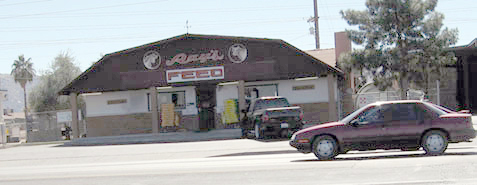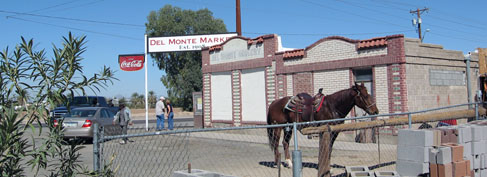|
|
||||
Ray’s Feed Store
Walking into Ray’s Feed Store is like going back in time. The shop has been there since 1981, so it is not an historic building. Once you step in the door, though, there is a feeling that this is another world. It is cool, dark with the mingled scents of feed and leather. A large parrot calls out to people who come in with a crackling “hello.” The customers do not answer. However, most of those customers do greet Ray Trujillo by name and he uses the customer’s name in reply as well. One man who was the owner of a nearby plant nursery consulted Ray on a way to get rid of some javalina who were plundering his vegetation. Ray said he had a similar problem with coyotes and offered advice on their removal. When the customer left, Ray explained that he had known the man since he was a child. Ray spoke proudly of the businessman he had become and how he had followed in the footsteps of his father. Ray said that the area looked like a ranch when he first arrived. He feels that things started to change just over two years ago. Then, “From Central [Avenue] this way, you didn’t see any house until two years ago. Everybody wants a house in South Phoenix. Prices went up like crazy.” Ray and Angie owned ten acres of land in back of the business. He related that there was constant pressure to sell the property until he finally did so. I told Ray that I had taken a ride through that subdivision just before arriving for the interview. I had no way of knowing that the property had once belonged to him, but I was curious because the property was so different in appearance to the surrounding homes. The subdivision was typical of new homes in the Phoenix area, tiny lots bursting at the seams with luxury accommodations. Of course the ubiquitous gate was present to voice exclusivity and security as Edward Blakely and Mary Snyder discuss in Architecture of Fear (1997, 85-99). On this day the gate was fixed to stay open. The welcome may have been because there were many “for sale” signs scattered throughout. I called one of the agents and got a recorded message. The house was described as a five bedroom home with many amenities. The price tag was $380,000. Ray explained that when the property was first purchased, the developer said that there would be 32 homes on the ten acres. They ended up building 58 homes. He does not begrudge anyone making a profit on the land because he did so when he sold it. When I remarked about the amount of for sale signs, Ray said that the developer told him that they were mostly all sold, just waiting for the paperwork to go through. He added that brokers had bought some of the homes for speculation. The initial price range was $120,000 to $160,000, but the housing prices doubled by the time they were built. Ray had a horse boarding business on the land and he was going to sell a portion of it. The developer wanted the whole ten acres and Ray thought that eventually the new homeowners would just complain about the flies and smell of the horses anyway so he sold the whole parcel. During the interview there was a steady stream of customers moving in and out quickly. Angie smoothly alternated between Spanish and English. She asked customers about family and health. When there was a lull in the stream of customers, she interjected bits of information or showed off a family picture. Both Angie and Ray agree that they are not used to so many people living in the area. Ray noted, “We were like a farm community. You can’t even drive down Baseline without somebody honking at ya’.” Ray Trujillo’s family moved to Arizona from Texas. He said that there was no hope for a better life in that part of Texas, so his parents and nine brothers and sisters moved to South Phoenix. He quit school in the 9th grade to help with the family’s finances, as did most of his siblings. Later he obtained a GED. Ray explained that he always wanted to have something of his own. He had been a truck driver for 15 years before becoming a produce manager for Bayless markets for 12 years. He obtained the building that had had a previous life as a restaurant, boarding house, and church, in 1981. Ray described the previous owner as an old man who was ready to retire and wanted him to have the business. He let Ray have it the first year, rent free. Angie quit her job at Motorola. She and their son ran the business for a year, before Ray left Bayless. During that year, Ray would do the ordering and other business at night. They started slowly fixing up the building with the help of a friend who was a carpenter, as the business grew. Angie interjected that there was a dirt road out front when they started. The family has lived in a home on five acres near 27th Avenue and Baseline. The family has run a small farm for the last eight years. A neighbor has complained about his animals and farm equipment, but there are others that do not seem to mind. According to Ray and Angie, the petition was to prevent the change in zoning that would limit the type and amount of animals that a person could keep on their property. He planned to attend a neighborhood meeting that was schedule for March 6th at the Laveen Elementary School. He is worried about his business without the animals around to feed, groom and medicate. Ray also expressed concern for people who have dreamed about owning a small farm only to have their hopes dashed by restrictive legislation. I could visualize the reasons for his frustration. Earlier in the day, I had driven down Dobbins Road to locate the Laveen Elementary School during the daylight hours. It was a beautiful drive, a two lane road with farms on one side and homes nearer South Mountain. I stopped at a handsome old building.
As I got out of the car and looked around, I noticed a man riding a horse across a plowed field. He stopped a few times and worked the horse backward and through turns before riding across Dobbins Road to the store. He tied the horse up to a hitching post outside and went in for a cool drink. He wore a City of Phoenix patch on his shirt. After a few minutes he emerged with the owner of the store and she showed him her new pickup. They share a few more minutes of conversation, the rider got back on the horse and rode north on the side of 27th Avenue. The store owner spoke a few words with several customers who entered. This was very much like greetings and banter at Ray Trujillo’s store. However, inside this store there were specialties to attract the new neighbors. A gourmet coffee display and wine rack were prominent among the convenience items. The store looked like an antique from the outside, but inside there was marketing targeted to the new, evolving South Phoenix customers. |
||||
|
||||


